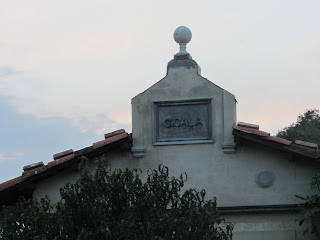The first set of memorable wines were encountered at our Luma Cellar tasting where two of the three bottles in our second Burgundy flight were drawn from the fabled 1947 vintage, considered by some to be the greatest Burgundy vintage ever. The first bottle of the flight, the Remoissenet 1947 Chambertin Clos de Beze, drank like a 1990 in that it was amazingly rich and youthful. Manifestation of the classic soy and Asian spice notes. Really a step up over the 71’s. The Drapier 1947 Romanee St.-Vivant was very aromatic. A nose of cherry, cinnamon, clove, and Asian spice. Classic Romanee St.-Vivant, feminine and aromatic but not as powerful or rich as the Clos de Beze. The final wine in this flight was the 1961 Hudeolet Bonnes Mares. Dark color, very spicy and floral. Someone referred to it as almost-perfume-like. A great flight of Burgundies.
The Night of Wines at Victoria and Albert's was plenty bountiful. The 1937 Boisseaux-Estivant Bourgogne Réserve de la Chevre Noire was one of the biggest surprises of the night. A bouquet of sour cherry, mushroom, and orange peel with sweet and smokey barbecue tones and an intensity which held for at least an hour. All you could ever expect from a Bourgogne!
The 1959 Caves du Chateau F 'Troyes Clos Vougeot had a soaring nose of red fruit, asian spice, iron, soy, and beef broth. This wine had incredible length and richness on the palate and seemed to get better with time. This was the group’s wine of the flight.
The Bordeaux flight and was led off by a 1966 La Mission Haut Brion. Wow! It has been a long time since we had a Bordeaux that beat the Burgundies and this was the Groups’ WOTN. This wine presented a kaleidoscope of flavors beginning with sweet blackcherry, smoke, tar, cigar box, soy, spice, and mineral. The finish is near perfect as it has reached it's peak. Well-stored bottles will keep for several more years.
One of the great Dominus vintages -- and one of the true Napa greats -- the 1991 Dominus would have been identified as a great Bordeaux if it had been placed blind into this flight. This wine is fully mature and showing amazing complexity with black currants, cedar, leather, tobacco, and earth. Long finish. Very Pauillac-like. The 1991 never disappoints.
The 2000 Rayas CdP showed cherry, kirsch liqueur and rose petal on the nose. Rayas to me is the most Burgundian of the CDP's and this vintage shows it's elegance and purity of fruit. The group seemed to really love this wine. They have almost become impossible to find. Groups’ WOTF.
The next wine in the flight was the 2000 Usseglio Deux Freres CdP. Next to the Rayas this has always been one of my favorite CdPs. This wine kept getting better in the glass. Nose of garrigue, earth, kirsch, licorice, and flowers. Saucy texture with a beautiful finish.
The 1947 Pierre André Chambolle-Musigny was the leading wine at our Chatham’s wine dinner. Wow! Massive red fruits, very sweet, ripe with great acidity. A touch of tomato and protein. This wine showed much younger than its age.
The 1999 Chapoutier L'Ermite and 1990 Les Cailloux Cuvée Centenaire were opened and tasted together. The Chapoutier had a nose of blueberry, roasted nuts, pepper, and herbs. Meaty with a shoe polish finish. These wines will age effortlessly for 50 + years. I had high hopes for the Les Cailloux and it delivered. Very sweet and opulent Kirsch fruit. Almost Burgundian but more rustic with soy, balsamic, iron, and beef blood in the mouth. I love CdP and this was a great one!
The Gruaud Larose 1982 showed sweet black fruits with spice and cigar box. Great aromatics with some barnyard and earth. This wine was reminiscient of the smell and taste of the 1966 La Mission Haut-Brion but was fresher. I feel this is the best vintage of Larose since the '61.
At the Vintage Rioja Wine Tasting at the Bull and the Bear, the stunner was the 1925 Marques de Riscal which ended up as the wine of the flight and of the night. This wine was opened just prior to pouring because we were afraid that it might be too delicate to survive extended exposure to the elements; but it got better with the passage of time and three hours later it was running at top speed. Phenomenal.
While all of the preceding wines were trully phenomenal, the wine of the year for me was the 1958 Biondi Santi Brunello Reserva consumed at dinner at Terra Mia. This was truly one of the best Brunello’s that I have ever consumed and it was in really good shape. It started off as almost Burgundian (Russell thought more like a Barolo) and was opulent and sexy. It had a nose of cherry, orange peel, and mushroom. On the palate very rich red fruits along with some basalmic and tobacco notes, perfect acidity, and balance. The wine presented as much younger than its years.
Here is to more great bottles in 2013.
©Wine -- Mise en abyme






















































